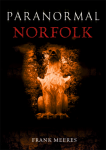
Reviewed by Tom Ruffles
Authors of regional paranormal books generally fall into one of two categories: those who carry out (what in some cases can only be loosely described as) psychical research; and local historians who are strong on library resources but don’t have much if any primary material to share. Frank Meeres (author of Norwich Through Time and Thetford and Breckland Through Time, both from Amberley, as well as a number of books about other aspects of East Anglian history) falls into the latter category, and he has relied heavily on papers in the Norfolk Record Office, where he is a Senior Archivist, for his rather random look at strange Norfolk, a big county with a lot of strangeness in it.
The book kicks off with John Polidori, Lord Byron’s doctor and author of The Vampyre, who happens to have lived in Norwich for a while. Meeres wonders if elements of his novel could have been inspired by his time in the city, a plausible assumption. More substantial is the chapter on Black Shuck, though it adds nothing new to the subject, and does not mention Simon Sherwood, who has been collecting accounts for some years, and who gave a talk on ‘Apparitions of Black Dogs’ to the 2010 SPR conference. A chapter on witches gathers together a few stories from the area.
Ghosts are divided by location: essentially rural, urban, clerical and modern. This is a useful compilation for the casual reader, with many old standards, such as - to take a few at random - the Drummer Boy of Hickling Broad, Blickling Hall, the haunted bridge at Potter Heigham, the ghostly monk seen hanging at St Benet‘s Abbey (though Meeres does not include the information that it is supposed to be a cyclical ghost which appears on 25 May each year; I have been and found the place heaving, but Edric failed to materialise), and more. Raynham Hall is another old standard, but it is disappointing to see the Brown Lady photograph discussed without reference to the recent research which has shown that there is far more to the story than is contained in general ghost books, and with suggestions how it was probably faked. Accounts gathered by local historian W H Cooke are given their own chapter. There is no index, which makes locating a particular story can be awkward as it can be in one of a number of places.
Long chapters are devoted to the Snettisham and Syderstone ghosts. The former relies heavily on Rev. Rowland Maitland’s authoritative booklet, which is credited, and adds further information, but the latter, mostly comprising long screeds of correspondence, could have acknowledged its obvious debt to Eliot O’Donnell‘s Ghostly Phenomena and Haunted Places in England. By the way, if anyone wonders why there appears to be little reference to the Snettisham Ghost in the SPR’s publications (despite Alan Gauld calling it "famous" in an article on Andrew Lang, who covered it in his The Book of Dreams and Ghosts, as did Andrew MacKenzie in Hauntings and Apparitions), that is because (as Maitland notes, but Meeres does not), it was not called Snettisham, Norfolk when details were first published, but instead Meresby, Suffolk. It is Case P. 220 in Frederic Myers’s ‘The Subliminal Self’ in Volume 11 of Proceedings.
Meeres’ primary interest appears to be true crime, and there is a lot of it in the book. On occasion it can obscure any paranormal element - for example, we get quite a long narrative about William Suffolk murdering his mistress when she dumped him in 1797, and his subsequent confession is printed verbatim, but the payoff is merely three lines recounting an anecdote that some unspecified children in the 1980s, playing at the spot where the gibbet which held his body was supposed to have stood, saw a skeleton lying on the grass, but it had disappeared when they returned with their parents. Other stories similarly have a thin paranormal component, though they still make good yarns - an entire chapter on the non-paranormal babes in the wood ends with the information that one may still hear them wailing on dark stormy nights (nothing to do with the wind in the trees of course).
Frank Meeres has produced a nicely illustrated and enjoyable book, on its own terms, one which will be of interest to those seeking an overview of the supernatural in Norfolk, as found in its central archives. It will hopefully encourage readers to find out more about this beautiful part of the country, and perhaps to delve further into its rich paranormal heritage.
Amberley publish a large number of regional guides to the paranormal.
Their website is at: http://www.amberleybooks.com.

